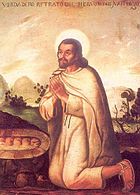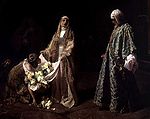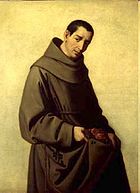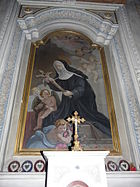- Miracle of the roses
-
The miracle of the roses is a Catholic miracle in which roses announce the presence or activity of God (see below: The legend).[1] Such a miracle is presented in various hagiographies and legends in different forms,[2] and it occurs in connection with diverse characters such as St. Elisabeth of Hungary (1207–1231), St. Elizabeth of Portugal (1271–1336), and Our Lady of Guadalupe (appeared in 1531).
A symbol of love already in Greek and Roman literature, in the Middle Ages the rose became endowed with Christian symbolism. By the twelfth century, it has come to stand for the pleasures of the Garden of Eden and becomes associated with the Virgin Mary in her dual role as bride and mother; signaling the multivalence of Christian symbolism, the red rose by this time signifies the sorrow of Christ's passion, and martyrdom in general.[3] It is in this period, the High Middle Ages, that the miracle of the rose appears in its different permutations, often as a female symbol, either because of the presence of the Virgin Mary or because the roses appear in the hands of a woman.
Contents
St. Elisabeth of Hungary
In Western Europe, the best-known version of a miracle of the roses concerns St. Elisabeth of Hungary (better known in Western Europe as St. Elisabeth of Thuringia), the daughter of King Andrew II of Hungary, who spent most of her life living with her in-laws in Germany, the rulers of Thuringia, who kept court at Wartburg Castle.[4]
Origins
The legend originates perhaps in a sermon given by Caesarius von Heisterbach in which he reflects on the occasion of the translation of the remains of St. Elisabeth, in 1236. Caesarius speaks of a sweet aroma that emanates from the grave as soon as it is opened (a common theme in hagiography).[5] Perhaps this either metaphoric or literal aroma then was translated into a physical event, the miracle of the roses.[4] The first actual miracle resembling that of the roses is described by Franciscans in the mid-13th century, but in their account the roses are spring flowers, and the event takes place in Hungary, at Elisabeth's home when she is only five.[6] The miracle as we know it, with roses and in Germany, is first attested in 1332, in a Franciscan book of prayers,[4] though it has also been proposed that the miracle was "translated" from St. Elisabeth of Portugal to St. Elisabeth of Thuringia in the nineteenth century.[7][8]
The legend
In its most characteristic form the legend goes as follows. One day the young but pious St. Elisabeth, in the company of one or more serving women, descends from Wartburg Castle down to the village of Eisenach, below the castle. She is carrying meat, eggs, and bread under her mantle. Supposedly she has taken items from the family dining table to distribute to the poor in the village, against the wishes of her family, who frown upon such behavior. Halfway down, she unexpectedly meets her husband Ludwig IV of Thuringia, who asks, upon seeing her bulk, what she is carrying. Embarrassed and speechless as she is, she does not know what to say. Ludwig opens her mantle, and to his surprise (in some versions this takes place in the dead of winter) finds her carrying a bouquet of roses.[6]
Similar versions
St. Elisabeth of Portugal


St. Elisabeth of Portugal Very much the same story is told of St. Elisabeth of Portugal, also known as Elizabeth of Aragon (1271–4 July 1336), who was the great-niece of St. Elisabeth of Thuringia. Married to the profligate King Denis of Portugal, she, like her great-aunt, showed great devotion at an early age, and likewise was charitable toward the poor, against the wishes of her husband. Caught one day by her husband, while carrying bread in her apron, the food was turned into roses. Since this occurred in January, King Denis reportedly had no response and let his wife continue. The story is somewhat apocryphal; while it shows up in popular versions of the saint's life,[9][10] the account is missing from more authoritative sources such as the revised 1991 edition of Alban Butler's Lives of the Saints.[11]
St. Casilda of Toledo
Similar also is the legend of St. Casilda of Toledo (d. ca. 1050), a daughter of a Muslim king of Toledo, Spain during the rule of the Caliphate, who showed special kindness to Christian prisoners.[12][13] She would carry bread hidden in her clothes to feed these prisoners; one day, when caught, they were miraculously changed into roses.[14] In the famous painting of St. Casilda by the 17th-century painter Francisco Zurbarán, roses are visible in the saint's lap; the miracle is also depicted in a painting by the 19th-century painter Jose Nogales. But while St. Casilda supposedly died in the eleventh century, predating the birth of both Elisabeth of Hungary and Elisabeth of Portugal, her hagiography was not written until three centuries after her death, and is likely influenced by the legend of either of these Elisabeths.[15]
St. Didacus of Alcalá
Of the 15th c. Franciscan St. Didacus of Alcalá, also known as San Diego, the same miracle is told: as a lay brother of the Franciscans in Spain, he often took bread from the monastery's dining table to give to the poor. One day, leaving the convent with a cloak full of food, he was accused and challenged to open his cloak; miraculously, the loaves of bread had changed into roses.[16][17]
Our Lady of Guadalupe


Miguel Cabrera, Juan Diego The story of Our Lady of Guadalupe is of an entirely different character, although here again the miraculous presence of the roses in the middle of winter is a sign of the presence of the divinity. The account is a corollary to a Marian apparition, Our Lady of Guadalupe, found in the 1556 booklet Nican Mopohua, and supposedly taking place in 1531.[18] It concerns a native inhabitant of Mexico named Juan Diego, whom the Virgin chooses to convey a message to an unwilling bishop, that "Here I will hear their weeping, their sorrow and will remedy and alleviate all their multiple sufferings, necessities and misfortunes." The bishop however, does not believe Diego's story. He returns to his field, where again the Virgin appears to him, with the same message. Diego again goes to the bishop, with the same result, and the remark that he has to bring a token if he is to be believed. The fourth time the Virgin appears, she directs Diego toward "varied Castilian flowers" which he picks; she then places the flowers in his mantle.[19] (The identification of these flowers as Castilian roses is a later addition.) This time the bishop is convinced, especially when an image of the Virgin miraculously appears on Diego's cloak.[20]
St. Rita of Cascia
A miracle involving roses occurred to St. Rita of Cascia. The winter before the end of her life in this world, a cousin visited St. Rita of Cascia and asked her if she desired anything from her old home at Roccaporena. St. Rita responded by asking for a rose and a fig from the garden. It was January and her cousin did not expect to find anything due to the snowy weather. However, when her relative went to the house, a single blooming rose was found in the garden, as well as a fully ripened and edible fig. Her cousin brought the rose and fig back to St. Rita at the convent, who thanked her and gave the rose to her sisters.
The rose is thought to represent God's love for Rita and Rita's ability to intercede on behalf of lost causes or impossible cases. Rita is often depicted holding roses or with roses nearby, and on her feast day, churches and shrines of St. Rita provide roses to the congregation that are blessed by priests during Holy Mass.Statement of the Holy Father John Paul II
In occasion of the centenary of the canonization of St. Rita of Cascia, Pope John Paul II mentioned this miracle in his address[21] to the pilgrims, stating that the worldwide devotion to St. Rita is symbolized by the rose, and that it is to be hoped that the life of her devoted pilgrims will be like that rose picked in the garden of Roccaporena before her death. The Holy Father added that St. Rita spiritually offers her rose to each of her pilgrims as an exhortation to be witnesses to a hope that never disappoints.
See also
References
- ^ Lafaye, Jacques (1987). Quetzalcoatl and Guadalupe: The Formation of Mexican National Consciousness, 1531-1813. University of Chicago Press. pp. 55. ISBN 0521420180. http://books.google.com/?id=fWJJua4aoGcC&pg=PA55&dq=%22Miracle+of+the+roses%22+%22God%22. Retrieved 11 December 2008.
- ^ Klaniczay, Gábor (2002). Holy Rulers and Blessed Princesses: Dynastic Cults in Medieval Central Europe. Cambridge University Press. p. 422. ISBN 0521420180. http://books.google.com/?id=tz12J0Eb9eUC&pg=RA1-PA422&dq=%22Miracle+of+the+roses%22+%22hagiography%22. Retrieved 11 December 2008.
- ^ Wilson, Jean C. (2004). "'Richement et pompeusement parée': the collier of Margaret of York and the politics of love in late medieval Burgundy". Excavating the Medieval Image: Manuscripts, Artists, Audiences; Essays in Honor of Sandra Hindman. Ashgate. pp. 109–134. ISBN 9780754631439. http://books.google.com/?id=dez8trnjfbUC. 118.
- ^ a b c Reber, Ortrud (1982). Die heilige Elisabeth: Leben und Legende. St. Ottilien.
- ^ Maresch, Maria (1931). Elisabeth von Thüringen: Schutzfrau des deutschen Volkes. Bonn: Verlag der Buchgemeinde. p. 220..
- ^ a b Hohberg, Rainer; Weigelt, Sylvia (2006). Brot und Rosen: Das Leben der heiligen Elisabeth in Sagen und Legenden. Wartburg: Wartburg Verlag. ISBN 9783861601838.
- ^ Pörnbacher, Hans (2003). Die hl. Elisabeth von Thüringen. Regensburg: Schnell und Steiner. p. 20. ISBN 3795480221. "Diese Episode wurde spät erst von Elisabeth von Portugal auf 'unsere' Elisabeth übertragen. . . . Im 19. Jahrhundert erst wurde die Legende durch die Nazarener aus Italien importiert (M. Hartig)."
- ^ Hartig, Michael (1931). "Die hl. Elisabeth von Thüringen und die deutsche Kunst: Eine ikonographische Studie". Die christliche Kunst 27: 194–223.
- ^ "Saint Elizabeth of Portugal". The Portuguese in the United States. Library of Congress. 1998. http://www.loc.gov/rr/hispanic/portam/isabel.html. Retrieved 2008-12-13.
- ^ "St. Elizabeth of Portugal - July 8". Plinio Corrêa de Oliveira. Tradition in Action. 2008. http://www.traditioninaction.org/SOD/j245sd_ElizabethPort_07_081.html. Retrieved 2008-12-13.
- ^ Butler, Alban; Michael J. Walsh (1991). Butler's Lives of the Saints. HarperCollins. p. 205. ISBN 9780060692995. http://books.google.com/?id=SoUCc0CA7g4C.
- ^ "Burgos". Catholic Encyclopedia. 1914. http://www.newadvent.org/cathen/03065c.htm. Retrieved 2008-12-13.
- ^ "April 9: St. Casilda". Saint of the Day. American Catholic. 2008. http://www.americancatholic.org/Features/SaintOfDay/default.asp?id=1898. Retrieved 2008-12-13.
- ^ Husenbeth, Frederick Charles (1860). Emblems of Saints: By which They are Distinguished in Works of Art. Longman, Green, Longman, and Roberts. p. 33. http://books.google.com/?id=ch2bY6YidZEC&pg=PA33&dq=saint+casilda.
- ^ Weinstein, Donald; Rudolph M. Bell (1986). Saints and Society: The Two Worlds of Western Christendom, 1000-1700. Chicago: U of Chicago P. p. 256. ISBN 9780226890562. http://books.google.com/?id=PfUugMi7VUEC.
- ^ Halavais, Mary H. (1999). "Rev. of La Historia de San Diego de Alcala. Su vida, su canonizacion y su legado by Thomas E. Case". The Journal of San Diego History (San Diego Historical Society) 45 (4). http://www.sandiegohistory.org/journal/99fall/alcala.htm. Retrieved 2008-12-22.
- ^ Tabor, Margaret Emma (1908). The Saints in Arts: With Their Attributes and Symbols Alphabetically Arranged. Frederick A. Stokes. p. 59. http://books.google.com/?id=MdMYAAAAYAAJ.
- ^ Rodriguez, Jeanette (1996). "Sangre llama a sangre: Cultural Memory as a Source of Theological Insight". Hispanic/Latino Theology: Challenge and Promise (Fortress): 117–33. ISBN 9780800629212.
- ^ Cawley, Martinus (1984). Guadalupe: from the Aztec language. CARA Studies of Popular Devotion No. 2: Guadalupan Studies No. 6. Guadalupe Abbey.
- ^ "Shrine of Guadalupe". Catholic Encyclopedia. www.newadvent.org. 1914. http://www.newadvent.org/cathen/07043a.htm. Retrieved 2008-12-06.
- ^ "Address of Holy Father John Paul II on the centenary of St. Rita's canonization.". 20 May 2000. http://www.vatican.va/holy_father/john_paul_ii/speeches/2000/apr-jun/documents/hf_jp-ii_spe_20000520_santa-rita_en.html.
Categories:- Christian hagiography
- Catholic terms
- Legends
- Roses
- Catholic spirituality
- Christian miracle narrative
Wikimedia Foundation. 2010.




